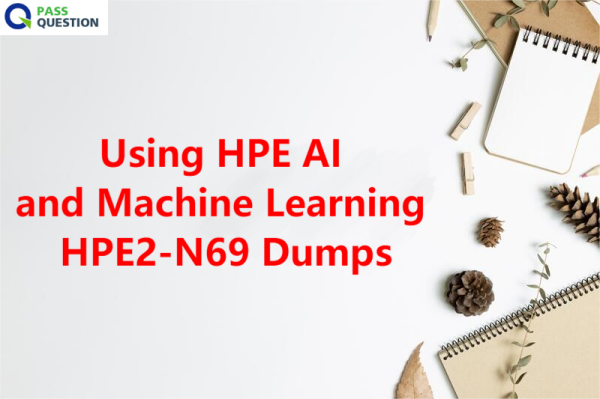Using HPE AI and Machine Learning HPE2-N69 Dumps
Are you preparing for your HPE2-N69 Using HPE AI and Machine Learning exam? PassQuestion team has collected Using HPE AI and Machine Learning HPE2-N69 Dumps which are designed to cover the knowledge points of the HPE2-N69 exam and enhance candidates' abilities. With PassQuestion Using HPE AI and Machine Learning HPE2-N69 Dumps, you can pass the HP HPE2-N69 exam easily and go further on HP career path. We highly recommend you study our Using HPE AI and Machine Learning HPE2-N69 Dumps multiple times so you can pass your HPE2-N69 exam successfully.

HPE2-N69 Exam Overview - Using HPE AI and Machine Learning
HPE2-N69 exam tests the candidate's ability to display competency in the use of the HPE Machine Learning Development environment, including the ability to understand the challenges customers face in training Deep Learning models, describe how the HPE Machine Learning Development Environment fits in the market, and design and use HPE Machine Learning Development Environment and System solutions.
Ideal candidate
The ideal candidate for this exam includes those who will design and support solutions through the use of HPE Machine Learning Development Environment to easily implement and train machine learning models by removing complexities, optimizing cost, and accelerating innovation.
Exam Details
Exam ID: HPE2-N69
Exam type: Web based
Exam duration: 1 hour 30 minutes
Exam length: 40 questions
Passing score: 65%
Delivery languages: Japanese, English, Korean
Exam Objectives
24% Understand machine learning (ML) and deep learning (DL) fundamentals
- 1.1 Have a conversation with customers about machine learning (ML) and deep learning (DL)
- 1.2 Understand the challenges customers face in training DL models
13% Articulate the business case for HPE Machine Learning Development solutions
- 2.1 Explain how HPE Machine Learning Development Environment helps customers surmount their challenges
- 2.2 Describe how HPE Machine Learning Development Environment fits in the market
15% Describe the architecture for HPE Machine Learning Development solutions
- 3.1 Describe the HPE Machine Learning Development Environment software architecture and deployment options
- 3.2 Describe the HPE Machine Learning Development System
33% Demonstrate and explain how to use HPE Machine Learning Development Environment
- 4.1 Demonstrate running a variety of experiment types on the HPE Machine Learning Development Environment
- 4.2 Explain how the Machine Learning Development Environment uses resources and schedules workloads
15% Engage with customers
- 5.1 Qualify customers for HPE Machine Learning Development Environment and System
- 5.2 Size HPE Machine Learning Development Environment and System solutions
- 5.3 Run a proof of concept (PoC)
View Online Using HPE AI and Machine Learning HPE2-N69 Free Questions
1. A customer is using fair-share scheduling for an HPE Machine Learning Development Environment resource pool. What is one way that users can obtain relatively more resource slots for their important experiments?
A.Set the weight to a higher than default value.
B.Set the weight to a lower than default value.
C.Set the priority to a lower than default value.
D.Set the priority to a higher than default value.
Answer: A
2. What is a reason to use the best tit policy on an HPE Machine Learning Development Environment resource pool?
A.Ensuring that all experiments receive their fair share of resources
B.Minimizing costs in a cloud environment
C.Equally distributing utilization across multiple agents
D.Ensuring that the highest priority experiments obtain access to more resources
Answer: B
3. A customer mentions that the ML team wants to avoid overfitting models. What does this mean?
A.The team wants to avoid wasting resources on training models with poorly selected hyperparameters.
B.The team wants to spend less time on creating the code tor models and more time training models.
C.The team wants to avoid training models to the point where they perform less well on new data.
D.The team wants to spend less time figuring out which CPUs are available for training models.
Answer: D
4. What distinguishes deep learning (DL) from other forms of machine learning (ML)?
A.Models based on neural networks with interconnected layers of nodes, including multiple hidden layers
B.Models defined with Apache Spark rather than MapReduce
C.Models that are trained through unsupervised, rather than supervised, training
D.Models trained through multiple training processes implemented by different team members
Answer: C
5. What common challenge do ML teams face in implementing hyperparameter optimization (HPO)?
A.HPO is a joint ml and IT Ops effort, and engineers lack deep enough integration with the IT team.
B.They cannot implement HPO on TensorFlow models, so they must move their models to a new framework.
C.Implementing HPO manually can be time-consuming and demand a great deal of expertise.
D.ML teams struggle to find large enough data sets to make HPO feasible and worthwhile.
Answer: A
6. Where does TensorFlow fit in the ML/DL Lifecycle?
A.it helps engineers use a language like Python to code and trail DL models.
B.it provides pipelines to manage the complete lifecycle.
C.It is primarily used to transport trained models to a deployment environment.
D.It adds system and GPU monitoring to the training process.
Answer: A
- TOP 50 Exam Questions
-
Exam
All copyrights reserved 2025 PassQuestion NETWORK CO.,LIMITED. All Rights Reserved.

